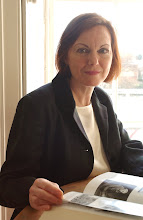 In the year of her 90th birthday in 1946, Eliza Jane Tuttle was interviewed for The Winnipeg Tribune. She is pictured daintily drinking tea from a blue Crown Derby cup for Mother’s Day. Her Honiton lace collar was made by one of her daughters, Mrs N McDougall, in Saskatoon, and her gold-rimmed locket held the pictures of two sons, Robert and Walwark, who were killed in the First World War. Her little gold brooch, ‘from my uncle’s shop in Devonshire’, held a lock of a sister’s hair.
In the year of her 90th birthday in 1946, Eliza Jane Tuttle was interviewed for The Winnipeg Tribune. She is pictured daintily drinking tea from a blue Crown Derby cup for Mother’s Day. Her Honiton lace collar was made by one of her daughters, Mrs N McDougall, in Saskatoon, and her gold-rimmed locket held the pictures of two sons, Robert and Walwark, who were killed in the First World War. Her little gold brooch, ‘from my uncle’s shop in Devonshire’, held a lock of a sister’s hair.It’s easy to imagine Eliza offering the newspaper reporter tea and buttered bread. ‘Have some,’ she urged. ‘My daughter makes wonderful bread. All my four girls learned to bake well.’ The reporter remarked that ‘Little Mrs Tuttle weighs 90 pounds, stands less than five feet, crochets and knits, puts on glasses just to read.' 'I don’t call myself old but I know I really am,' she smiled. Eliza and her husband Thomas came to Canada in 1882. ‘It was his idea,’ she recalled. ‘ He wanted some land. The government gave us a quarter section for $10. Later we got some more, 480 acres in all, near Minnedosa. He just loved the land, but I found it solitary. Later, there were enough of us to have square dances and enjoy ourselves.’
There was a dramatic story of arrival on the prairie. ‘Brandon was the terminus then. My husband left me there and walked over strange land the 23 miles to his brother’s log cabin. He didn’t know the way, of course, and walked far more than that. His feet … were so swollen from the icy water he stumbled into, they had to cut his boots off. Next day they came for me with a pair of horses. There was no bridge at Brandon and we had to ford the river. The tongue came out of the wagon and the water came in. I picked up my skirts but that was no good. I had to get out. I slid along the whiffle tree and they encouraged me by singing, “There’s One More River”.' A year later, in October 1883, she found the chimney of her log home on fire. ‘I could see the house had to go so I set to saving things. I got out the two chests that held our blankets and clothing, and my nice set of blue and gold china. I put my 14-months-old child on the feather bed and covered her up. She stayed outdoors all day long as I kept saving things. I got out the 100-pound bag of flour and the wheat. We didn’t have much furniture. I got it out, except for the stove. It had to stay. By late afternoon, the embers had died down and I set out, carrying the baby, to meet my husband. “You needn’t go any further,” I told him. “There’s no house. It’s burned to the ground.” We went to his sister’s homestead till we could rent a place.'
The Tuttles had eight children. They had a big dairy with 16 cows to milk and they made 50 pounds of butter a week, trading it for sugar and groceries at Rapid City. After her husband’s death, Eliza took turns living with her daughters. Two sons, Robert and Walwork, were killed in the Great War. On the wall of her home was framed a Biblical text – “Let me die the death of the righteous and let my last end be like His. Create in me a clean heart, O God, and renew a right spirit within me.” This was embroidered by Eliza Jane at the age of nine when she was living in Bloomsbury.
